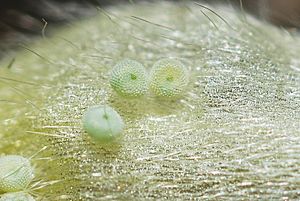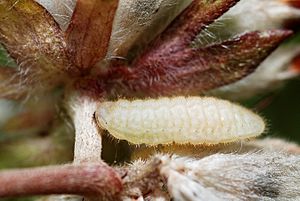Small blue facts for kids
Quick facts for kids Small blue |
|
|---|---|
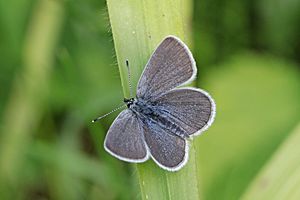 |
|
| Male | |
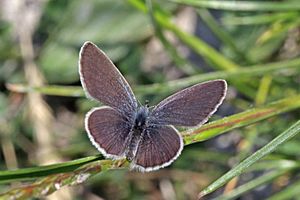 |
|
| Female both in Cotley Hill, Wiltshire |
|
| Scientific classification |
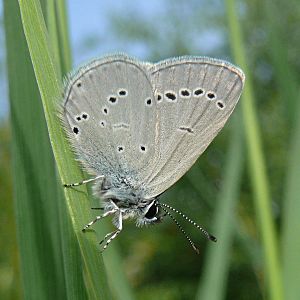
The small blue (Cupido minimus) is a tiny butterfly found across Europe and Asia. Even though it's called "small blue," it's mostly dark brown. Male butterflies might have a little blue near the base of their wings. These butterflies can live in large groups, sometimes with hundreds of them. Interestingly, when they are caterpillars, they can sometimes eat each other!
Contents
- What Does the Small Blue Butterfly Look Like?
- Where Do Small Blue Butterflies Live?
- Where Do Small Blue Butterflies Make Their Home?
- What Do Small Blue Butterflies Eat?
- How Do Small Blue Butterflies Reproduce?
- The Small Blue Life Cycle
- Subspecies of Small Blue Butterflies
- Why Are Small Blue Butterflies Important to Protect?
- Images for kids
What Does the Small Blue Butterfly Look Like?
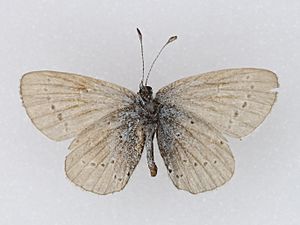
Male small blue butterflies are dark brown. They have tiny, bright blue scales scattered on their upper wings, making them look speckled. Female small blues do not have these blue speckles. Both males and females have shiny silver undersides with black spots. The male's underside also has a bluish tint near the wing base, similar to its upper side.
These butterflies are quite small. Their wings can spread between 16 and 27 millimeters wide. Males are usually a bit smaller than females. People sometimes confuse the small blue with the female Osiris Blue butterfly because their colors are alike.
Where Do Small Blue Butterflies Live?
The small blue butterfly lives in many places across the world. You can find them in Europe, parts of Asia like Asia Minor, Transcaucasia, and the Tian-Shan mountains. They also live in western, central, and southern Siberia, the Russian Far East, Amur, Mongolia, Magadan, and the Kamchatka area.
Small Blue Butterflies in the UK and Ireland
The small blue is known as the smallest butterfly in the United Kingdom. They are not found everywhere in the UK. They mostly live in chalk and limestone grasslands in southern England, like the Cotswolds and Salisbury Plain. In other parts of Britain and Ireland, they often live near the coast. There are also smaller groups in northern England and far northern Scotland. Because their numbers have dropped, the small blue is a special species that needs protection in Northern Ireland and under the UK Biodiversity Action Plan.
Where Do Small Blue Butterflies Make Their Home?
Small blue butterflies like to live in grassy areas that have lots of limestone in the soil. They can also be found in old quarries, along railway lines, on grassy banks, and at the edges of forests or in clearings.
What Do Small Blue Butterflies Eat?
Small blue caterpillars eat specific plants. Some of their favorite food plants include Lotus corniculatus (also known as Bird's-foot Trefoil) and Anthyllis vulneraria (Kidney Vetch). In the UK, small blue butterflies lay their eggs only on the kidney vetch plant. The caterpillars then live and feed on this plant.
While female butterflies get all their food from plants, male butterflies sometimes get salts and minerals from other sources. They might drink from mud puddles or even feed on dead animals or animal waste.
How Do Small Blue Butterflies Reproduce?
Mating Habits
When it's time to find a mate, male small blue butterflies will sit on a piece of grass or a small bush. They wait there for females to fly by. Males are very protective of their spot and don't like other males coming near. If a female who hasn't mated yet flies past, she will usually mate with the male without a long courtship. Females who have already mated try to hide in the grass to avoid other males.
Laying Eggs (Oviposition)
After mating, the female small blue butterfly looks for a good place to lay her eggs. She usually chooses a healthy food plant. She lays a single egg between two small flowers on the plant's flower head. This helps keep the egg hidden and safe. To stop other females from laying eggs on the same flower, the female rubs her belly on the flowers before she leaves. This leaves a scent that tells other butterflies the spot is taken. However, this scent doesn't last long, so sometimes multiple eggs are still found on one plant. If too many caterpillars hatch on the same flower, they might eat each other.
The Small Blue Life Cycle
Egg Stage (Ovum)
Small blue eggs usually hatch in one to three weeks. The exact time depends on where they are and how warm it is. The eggs are tiny, about 0.40 millimeters wide and 0.2 millimeters tall. They are light green with white patterns on them.
Caterpillar Stage (Larvae)
First Stage (First Instar)
When they first hatch, caterpillars are very pale blue, almost white, and have a black head. They are about 0.80 millimeters long when they emerge from the egg. They grow to about 1.3 millimeters by the end of this stage. These tiny caterpillars have small hairs all over their bodies. After hatching, they eat parts of the plant's flower and the young green seed pods where they were laid. Caterpillars in this first stage can also be cannibalistic, meaning they might eat smaller caterpillars if they find them.
Second Stage (Second Instar)
In the second stage, the caterpillar grows to about 4 millimeters long. Their hairs become thicker. Their head is still black, but their body turns a very pale yellow. By this point, they have a special scent gland on their back that you can see pulsing as they move.
Third Stage (Third Instar)
During this stage, the caterpillars continue to grow and can still attack and eat each other. They have even more hairs and are a deeper yellow color.
Fourth Stage (Fourth Instar)
By the fourth stage, the caterpillar is about 1 centimeter long. Their color can be pale green or pale yellow, and they have a stripe down their back. In late summer, they build small cocoons out of silk. They then stay still inside these cocoons for about ten months to hibernate through the winter. Their cocoons look like dead flower parts, which helps them hide from animals that might want to eat them.
Pupa Stage
The pupa stage, also called the chrysalis, lasts between one and three weeks. This also depends on the temperature. Caterpillars attach themselves head-up to the underside of a leaf or blade of grass. They use a silk thread to hold themselves in place. The pupa is light green with brown spots and small hair-like structures.
Adult Butterfly Stage (Imago)
Adult small blue butterflies live for about three months. In the southern United Kingdom, there are usually two groups of butterflies that hatch each summer. One group appears in June, and another, smaller group appears in August. However, in the northern parts of the United Kingdom, only the June group is present. Small blue butterflies are active during the day and often live in groups. Most groups have a few dozen butterflies, but some have been recorded with hundreds of individuals!
Subspecies of Small Blue Butterflies
One special type of small blue butterfly is called Cupido minimus trinacriae. This subspecies was identified in 1919 by Ruggero Verity and is found in Sicily.
Why Are Small Blue Butterflies Important to Protect?
In recent years, the small blue butterfly has lost many of the places where it lives in the United Kingdom. Because of this, it is now a "Priority Species" for conservation in Northern Ireland and under the UK Biodiversity Action Plan. It is also listed as one of the 41 most important species under special laws like Schedule 5 of the 1981 Wildlife and Countryside Act and the 1985 Northern Ireland Wildlife Order. This means it is very important to protect them and their homes.
Images for kids


